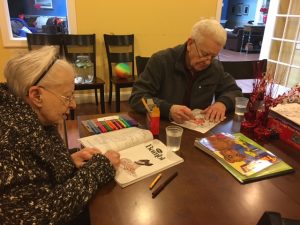
People often think art is for the elite, only important if created by one of The Masters, hangs in a museum, and is perfect. This is incorrect. Studies show that art, and making art, is important because it engages the mind, helps hand-eye coordination, and reduces anxiety and stress. It’s a form of self-expression and communication. Art is for everyone.
The benefits that come from creating art are important for those with Alzheimer’s. While it allows them to relax and enjoy the creative process, maybe more importantly, it allows them to connect to others. Creating art is a social activity, it can lead to conversations and reminiscing. Their artwork can be about memories, happy times, and the people they love. Art allows them to tell their stories and express themselves even if their language skills are diminishing.
One of the most convenient forms of art therapy is coloring. It is easily accessible and familiar. While you may need to help your loved one get started, a coloring project doesn’t require any complicated steps, instructions, or materials.
When selecting images to be colored, there are two key factors to consider. The first is content. You shouldn’t demean your loved one with a juvenile coloring book or frustrate them with a book of complicated patterns. If a book isn’t an option, you can find images online. Search for Coloring Images for Alzheimer’s, to find basic images that are easy to color but don’t look childish. Or search for images based on their area of interest. For example, Coloring images for baseball; or Coloring images for fashion. You can then print the images that are most appropriate.
The other factor is choosing tools. Safety should play a role in this decision. Stay away from writing instruments that are sharp or toxic. Don’t use materials that will be messy or complicated (paint/paint brushes may cause frustration). Crayons, with their color variety and distinctive smell, may remind many of happy times – but some could see them as childish and insulting. The decision of which tools to use should be based on the best interest of the individual.
Making art is not about creating perfection. It is about having fun, being social, and self-expression. This is especially important for those living with Alzheimer’s.
For more information, visit these helpful websites:
www.alz.org/care/alzheimers-dementia-music-art-therapy.asp#art
www.healdove.com/older-adults/Activities-for-Alzheimers-Coloring-for-Adults
